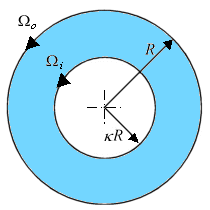Tangential annular flow between two coaxial rotating cylinders Problem. Consider an incompressible isothermal fluid in laminar flow between two coaxial cylinders, whose inner and outer wetted surfaces have radii of
kR and
R, respectively. The inner and outer cylinders are rotating at angular velocities
Wi and
Wo, respectively. End effects may be neglected.
 Figure.
Figure. Tangential annular flow between two slowly rotating cylinders. a) Determine the steady-state velocity distribution in the fluid (for small values of
Wi and
Wo).
b) Find the torques acting on the two cylinders during the tangential annular flow of a Newtonian fluid.
Solution. Step. Simplification of continuity equation
In steady laminar flow, the fluid is expected to travel in a circular motion (for low values of
Wi and
Wo). Only the tangential component of velocity exists. The radial and axial components of velocity are zero; so,
vr = 0 and
vz = 0.
For an incompressible fluid, the continuity equation gives

.
v = 0.
In cylindrical coordinates,



(1)
So,
vq =
vq (
r,
z).
If end effects are neglected, then
vq does not depend on
z. Thus,
vq =
vq (
r).
Step. Simplification of equation of motion
There is no pressure gradient in the
q-direction. The components of the equation of motion simplify to

(2)

(3)

(4)
The
r-component provides the radial pressure distribution due to centrifugal forces and the
z-component gives the axial pressure distribution due to gravitational forces (the hydrostatic head effect).
Step. Velocity profile by solving differential equation
The
q-component of the equation of motion is integrated to get the velocity profile:

(5)

(6)
The no-slip boundary conditions at the two cylindrical surfaces are

(7)

(8)
The integration constants are thus given by

(9)
On substituting for
C1 and
C2, the velocity profile is obtained as

(10)
The velocity distribution given by the above expression can be written in the following alternative form:

(11)
In the above form, the first term on the right-hand-side corresponds to the velocity profile when the inner cylinder is held stationary and the outer cylinder is rotating with an angular velocity
Wo. This is essentially the configuration of the Couette - Hatschek viscometer for determining viscosity by measuring the rate of rotation of the outer cylinder under the application of a given torque (as discussed below). The second term on the right-hand-side of the above equation corresponds to the velocity profile when the outer cylinder is fixed and the inner cylinder is rotating with an angular velocity
Wi. This is essentially the configuration of the Stormer viscometer for determining viscosity by measuring the rate of rotation of the inner cylinder under the application of a given torque (as discussed next).
b)
Step. Determination of momentum flux
From the velocity profile, the momentum flux (shear stress) is determined as

(12)
Step. Determination of torque
The torque is obtained as the product of the force and the lever arm. The force acting on the inner cylinder itself is the product of the inward momentum flux and the wetted surface area of the inner cylinder. Thus,

(13)
Similarly, the torque acting on the outer cylinder is obtained as the product of the outward momentum flux, the wetted surface area of the outer cylinder, and the lever arm. Thus,

(14)
The tangential annular flow system above provides the basic model for rotational viscometers (to determine fluid viscosities from measurements of torque and angular velocities) and for some kinds of friction bearings.